Filter Cover Bolt Hole Repair Kit
MODELS AFFECTED: All 3000 and 4000 Product Families Transmission
Models
Introduction:
To facilitate the repair of the filter cover bolt threads in the main case a Filter Cover Bolt Hole Repair IGT, J-42385-ALT has been released. The kit can be used for thread repair with any 3000 and 4000 Product Families model. The kit allows the threads to be repaired in or out of chassis. The kit utilizes a solid, thin-wailed, self-locking steel bushing insert to repair the filter cover bolt threads in the main housing of the transmission. The thread inserts repair the filter cover bolt threads to their original thread specification of an MI0 x 1.5.
The Filter Cover Bolt Hole Repair kit contains:
- Template J-42385-230 (Main Filter) • Insert Driver J-42385-233
- Template J-42385-234 (Lube Filter) • Tap Wrench Part Number 510260
- Two (2) Alignment Pins J-42385-308 • Six (6) MI0 Retaining Bolts Part Number 206158
- Ml0 Step Drill J-42385-231 • Driver OilJ-42385-110
- Tap J-42385-232
- 60 inserts J-42385-514, the kit contains six (6) packets of ten (10) MI0 x 1.5 x 24.5
The kit contains 60 inserts and 1 bottle of oil. Additional inserts and oil can be purchased through SPX Kent-Moore.
SPX Corporation (Kent-Moore Service Solutions)
28635 Mound Road Warren, MI 48092
Phone: 1.800.328.6657
Fax: 1.800.578.7375
Thread Repair Criteria:
Prior to beginning the field modification procedure, the filter cover bolt holes must be inspected to assure the MI0 Step Drill (1-42385-231) can properly prepare the bole for thread cutting with the Tap J-42385-232. If any of the filter cover bolt holes are found oversized the transmission main housing must be replaced.
NOTE: The Allison factory-installed steel inserts use the same hole and thread size as the Thread Repair Kit inserts; however, the MlO Step Drill J-42385-231 must be used to counter-sink the hole before the
Thread Repair Kit inserts are installed.
Field Modification Procedures:
The attached SPX Kent-Moore instruction sheet must be used to facilitate the repair of the filter cover bolt threads in the main case.
Allison Transmission, Inc.
Indianapolis, Indiana 46206-0894
Allison “MODE” Button
By Brett Wolfe 1993 U240 3/30/08 on RVNET
There are TWO TOTALLY DIFFERENT “LET THE TRANSMISSION CHOOSE THE CORRECT GEAR” MODES/PROGRAMS in the Allison ECU which is the “electronic brain” controlling shifting and other functions.
In ECONOMY MODE, the transmission will not downshift even at WOT (Wide Open Throttle) until the engine pulls down to peak torque RPM in some application and 200 RPM lower than “regular mode” in others. And similarly, on up-shift, the economy mode will shift into a higher gear EARLIER– with the difference only at or near WOT.
In REGULAR MODE, the transmission WILL downshift much earlier (to maintain higher engine RPM).
ONLY at higher throttle positions is there any difference, so on flat ground, you will NOT notice any difference (except accelerating from a stop IF you are at or close to wide-open throttle).
It can make a BIG difference in rolling hills. If you are in rolling hills and regular mode (particularly with the cruise control on), it is common for the transmission to shift down to 5th on the uphill and back to 6th on the downhill. Repeat this process hundreds of times. In economy mode, you will stay in 6th gear unless the hill is so steep or so long that the engine can not pull it without dropping below peak torque RPM. If you can pull a hill in a higher gear (lower engine RPM) AND the engine does not overheat, THAT IS WHAT CATERPILLAR AND CUMMINS RECOMMENDATION FOR THE MOST ECONOMICAL WAY TO CLIMB A HILL with a modern turbo, after-cooled diesel engine.
If you know you will need a lower gear because of the steepness of the grade and/or are engine temperature is rising higher than thermostatically controlled temperature, if driving in economy mode, use the down arrow to drop a gear (this is what I do) or switch out of economy mode. Be sure to switch back into an economy mode when past the steep section, or agree to pump extra fuel in the tank.
IF your engine begins to overheat, your HP/weight ratio is low OR if it irritates you to loose a few mph on a hill in the name of saving fuel, in the hills, by all means, drive in regular mode.
It confuses me to hear people advocate driving in economy mode only on flat ground, as there is not a 1% difference in shift RPM’s between regular and economy mode on flat ground, excepting accelerating from a stop if you use WOT.
Every time you start the coach, the transmission is in regular mode. This is the default setting. IF you push the mode button, it goes to “economy mode” AND the light illuminates.
There is no “absolute” on how much difference in fuel economy driving in economy mode will have. On the flat ground where you will be in 6th gear irrespective of what mode you are in, there will be ZERO difference. The MOST difference in mileage will be in rolling hills, wherein regular mode, particularly if on cruise control you will start up a hill in 6th gear, go to WOT in 6th gear, downshift of 5th gear still at WOT (WHERE IT IS USING A LOT MORE FUEL). After the hill is crested, the transmission will up-shift to 6th, then likely coast a little in 6th gear (unless you are driving with the exhaust brake on– if you are it then applies the exhaust brake AND downshifts TOWARD the pre-select gear which is generally either 2nd or 4th). And so on 6-5-6-5-6-5-6-5…….
A modern turbo inter-cooled diesel is much more efficient at low RPM high throttle settings. This is NOT my opinion. It is stated in just those words in the Cat Owner’s Manual and likely the Cummins manual as well.
Note: In either mode, you are free (and welcome) to use the up and down arrows to PRO-ACTIVELY choose the correct gear. You can not screw anything up– even if you down-arrow to 1st gear at 70 mph, the transmission understands that you meant “please downshift to the next lower gear as soon as the engine RPM will not exceed the pre-set amount. Then downshift again when safe…..”
By the same token, you can shift between regular and economy mode as often as you want with the transmission in any gear when you make the change.
OPINION: I drive in economy mode 99% of the time, including in REAL mountains, but use the up and down arrows to choose the proper gear. I use regular mode ONLY when I am willing to say, “I am willing to throw a lot of fuel away to gain a little performance.” When passing on 2 lane roads, THIS IS the case
Allison Automatic Transmission Driving Tips
By – Reprinted from Winter 2008 Motorcader
Situation:
HIGHWAY DRIVING Technique:
Operating in the “Drive” mode is recommended for normal driving conditions to reduce engine RPM for maximum fuel economy. Your Foretravel is equipped with an Allison Transmission with a second shift schedule option “mode selection button”, the model should be “ON” for secondary mode versus “OFF” for the primary mode.
Situation:
MOUNTAINOUS DRIVING (Up & Down Terrain) Technique:
Manually pre-select a lower gear in order to maintain engine speed within a range of 500 RPM of engine governed speed. Road speed may decrease but power (torque) will remain at peak output while ascending a grade. When descending a grade, never use a higher gear than was used climbing that same grade. The selection of a lower gear will also minimize cycling between gear and the next gear on a series of short up & downhills.
Situation:
CITY DRIVING (Stop & Go Traffic) Technique:
Select the highest range that will allow the vehicle to reach the speed you expect to maintain between stops. This will minimize cycling between gear and the next higher gear while driving in stop & go traffic conditions. When traffic conditions return to normal, move the selector back to the DRIVE position.
Situation:
DRIVING ON ICE OR SNOW Technique:
If possible, reduce your speed and select a lower gear before you lose traction. Select the gear that will not exceed the speed you expect to maintain. Accelerate or decelerate very gradually to prevent losing traction. It is very important to slow gradually when a lower gear is selected. It is important that you reach the lower gear selected before attempting to accelerate. This will avoid an unexpected downshift during acceleration.
Situation:
ENGINE BRAKING Technique:
To use the engine as a braking force, select the next lower gear. If the vehicle is exceeding the maximum speed for this gear, use the service brakes to slow the vehicle. Engine braking provides good speed control for going downgrades. When the vehicle is heavily loaded, or the grade is steep, it may be desirable to pre-select a lower gear prior to the grade. The transmission control system will inhibit a shift into any range at a speed that will cause an engine over speed. Any lower forward range may be selected at any time, but the actual engagement will not occur until road speed is reduced – downshifting is progressive as road speed decreases. The inhibit effect will cause downshifts to occur at slightly higher speeds than normal automatic downshifts.
For additional options information that will aid in your driving experience please see your Foretravel Owner’s manual.
For complete operating guidelines for each Allison Transmission model, reference the Allison Transmission Operator’s manual found in your owner’s packet.
Allison 4000 Transmission Leak
I noticed an occasional small drop of “oil” on the floor beneath the back of the transmission. It concerned me so I had mechanics and technicians look at it. I had checked fluid level, no detected loss.
Mike Rodgers checked and found nine bolts at about one quarter the spec torque required so he tightened them to specs. They then soaped and pressure cleaned the tranny, I drove and then crawled under several times to monitor the clean surfaces. The fluid seep around two bolts was visible, the tightening did not solve. Maybe more than the two bolts were involved, there are quite a few more than nine there.
I took the coach to Stewart and Stevenson. When I got there, about 100 miles, and parked, we noted the leak had increased from a drop or two, so timely to have looked at this. S & S took it apart and found three gaskets of the retarder plates needing to be replaced.
Photos of the bolts that were loose and the seep around them are attached. Maybe it would have continued many miles just leaking a little but that would have worried me.
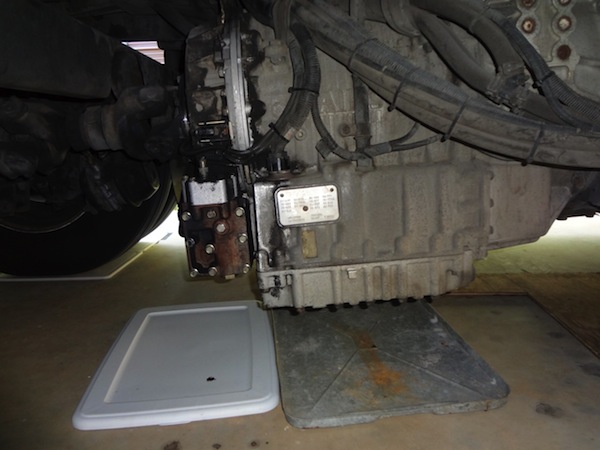
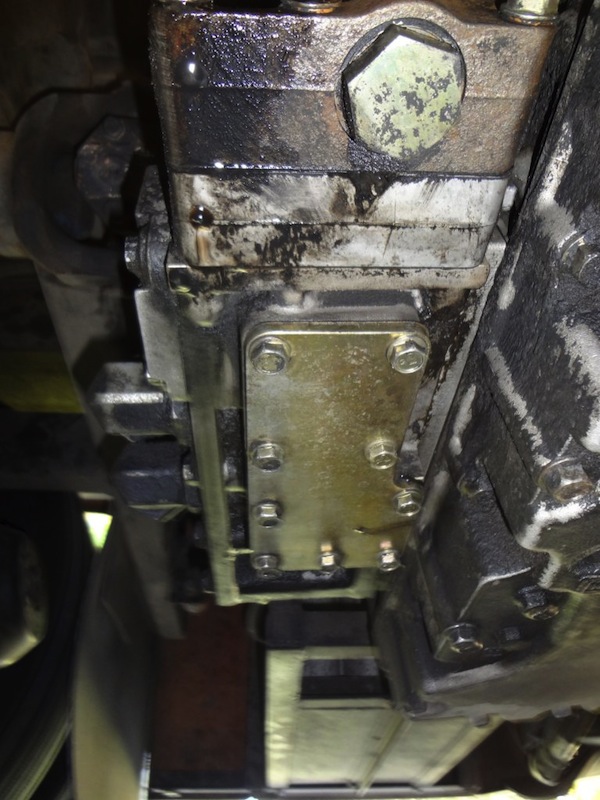
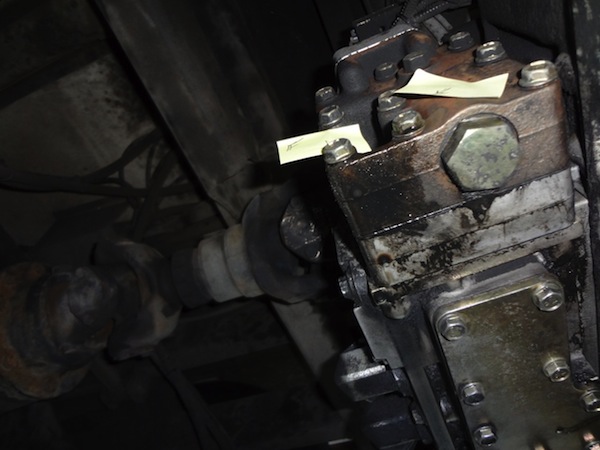
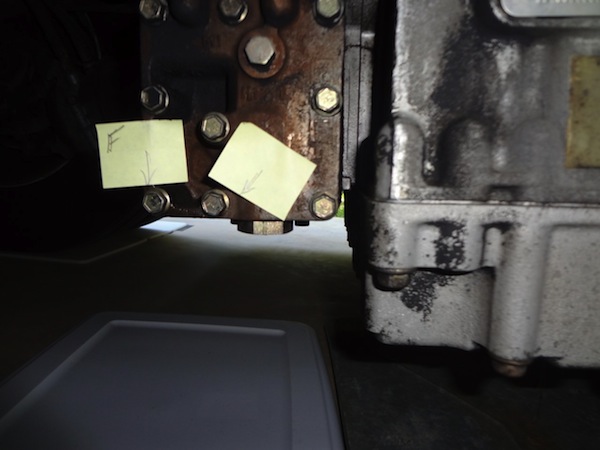
Maybe check these every, oh, 140,000 miles? Mike 2001 U320 40′
Retarder And P3 Planetary, Retarder Valve Body Module — Exploded View
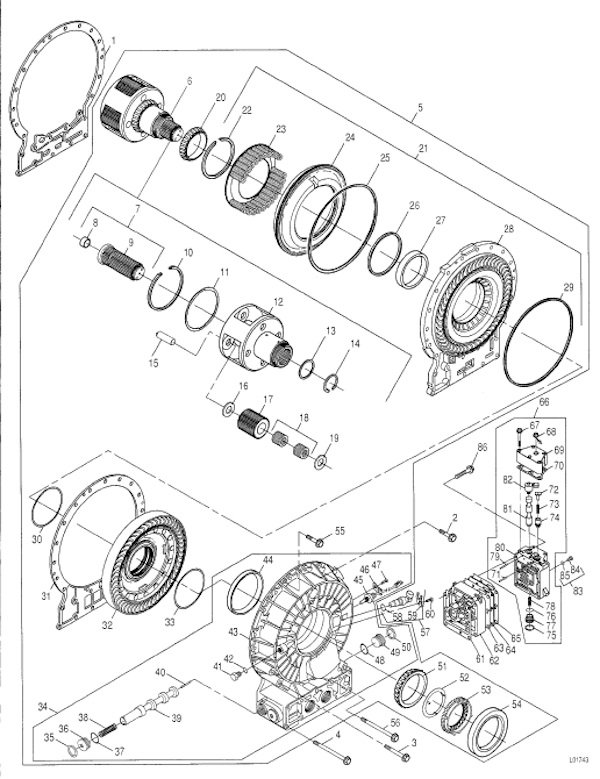
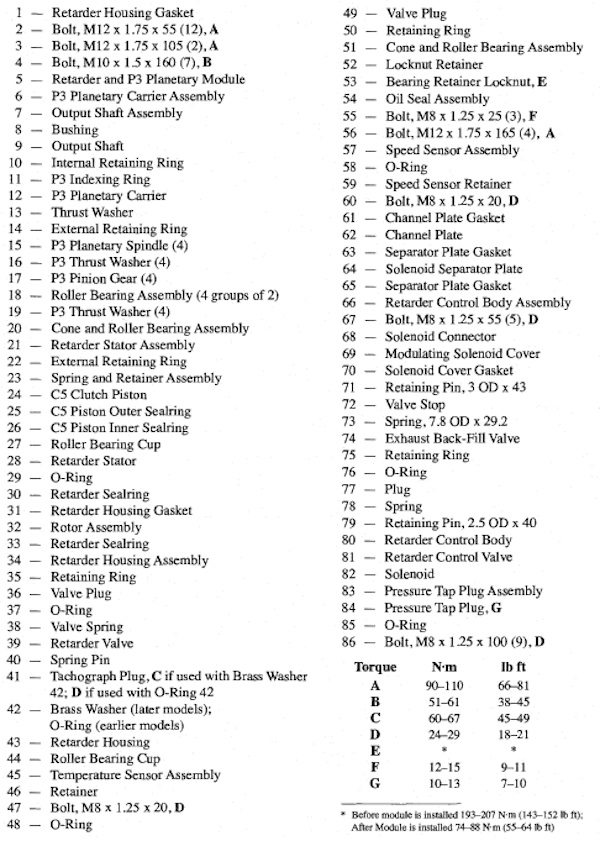
One of the methods for finding a leak is interesting; “The Powder Method. Clean the suspected area, apply an aerosol-type white powder, such as foot powder, to the suspected area, operate a vehicle under normal conditions, visually inspect the suspected area and trace the leak path over the white powder surface to the source. Dick, 2003 U320 40′
Allison Automatic Transmission Driving Tips
By – Reprinted from Winter 2008 Motorcader
HIGHWAY DRIVING Technique:
Operating in the “Drive” mode is recommended for normal driving conditions to reduce engine RPM for maximum fuel economy. Your Foretravel is equipped with an Allison Transmission with a second shift schedule option “mode selection button”, the model should be “ON” for secondary mode versus “OFF” for the primary mode.
MOUNTAINOUS DRIVING (Up & Down Terrain) Technique:
Manually pre-select a lower gear in order to maintain engine speed within a range of 500 RPM of engine governed speed. Road speed may decrease but power (torque) will remain at peak output while ascending a grade. When descending a grade, never use a higher gear than was used climbing that same grade. The selection of a lower gear will also minimize cycling between gear and the next gear on a series of short up & downhills.
CITY DRIVING (Stop & Go Traffic) Technique:
Select the highest range that will allow the vehicle to reach the speed you expect to maintain between stops. This will minimize cycling between gear and the next higher gear while driving in stop & go traffic conditions. When traffic conditions return to normal, move the selector back to the DRIVE position.
DRIVING ON ICE OR SNOW Technique:
If possible, reduce your speed and select a lower gear before you loose traction. Select the gear that will not exceed the speed you expect to maintain. Accelerate or decelerate very gradually to prevent loosing traction. It is very important to slow gradually when a lower gear is selected. It is important that you reach the lower gear selected before attempting to accelerate. This will avoid an unexpected downshift during acceleration.
ENGINE BRAKING Technique:
To use the engine as a braking force, select the next lower gear. If the vehicle is exceeding the maximum speed for this gear, use the service brakes to slow the vehicle. Engine braking provides good speed control for going downgrades. When the vehicle is heavily loaded, or the grade is steep, it may be desirable to pre-select a lower gear prior to the grade. The transmission control system will inhibit a shift into any range at a speed that will cause an engine over speed. Any lower forward range may be selected at any time, but the actual engagement will not occur until road speed is reduced – downshifting is progressive as road speed decreases. The inhibit effect will cause downshifts to occur at slightly higher speeds than normal automatic downshifts.
For additional options information that will aid in your driving experience please see your Foretravel Owner’s manual.
For complete operating guidelines for each Allison Transmission model, reference the Allison Transmission Operator’s manual found in your owner’s packet.